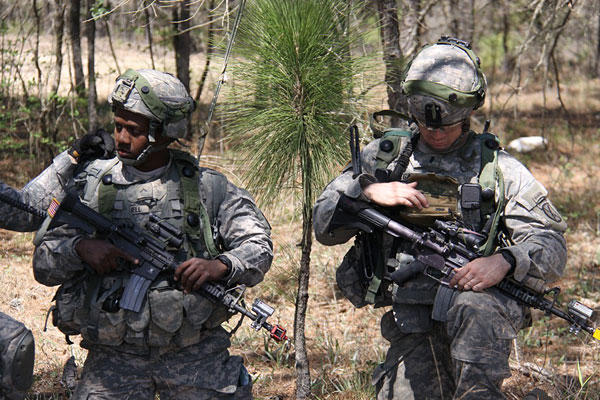FORT POLK, La. -- Soldiers assigned to the first U.S. Army brigade scheduled to deploy to Afghanistan with the service’s next generation combat radio system called the technology a “game-changer” as the 10th Mountain trained here ahead of an upcoming tour.
The suite of radios, networking systems, and software -- known in Army parlance as Capability Set 13 -- is designed to boost mobile connectivity. Infantry troops will be able to use a smartphone tethered to a digital radio to mark the locations of roadside bombs, share intelligence, and even send text messages.
The system gives soldiers patrolling on foot or riding in vehicles a similar level of connectivity as their counterparts back at headquarters. It will enhance front-line communications as the mission in Afghanistan shifts from combating insurgents to advising and assisting the Afghan security forces while also drawing down, said Col. Mark Elliott, who oversees development of the Army's tactical network.
“This is just in time for a retrograde mission,” he said, referring to the process of removing military equipment from an operating area. “We're pulling cables out of buildings because we're trying to turn the lights out.”
The equipment includes smartphones such as the Motorola Atrix running Google Inc.'s Android software; handheld AN/PRC-154 Rifleman Radios; portable AN/PRC-117G Falcon III radios; satellite dishes, and other pieces of hardware and software.
“We are completely digital as an Army with this system,” said Lt. Col. Alan Boyer, commander of the 2nd Battalion, 30th Infantry Regiment, 4th Brigade Combat Team, 10th Mountain Division. The unit is training with the technology here at its home base in preparation of a deployment to Afghanistan this spring.
“It allows us to have that mission command and that flatness among the smaller organizations, so that we can see ourselves, first and foremost, and also be able to rapidly pass information back and forth," he said. "That is a game-changer.”
The mission comes as the White House is pressing for a faster withdrawal of U.S. forces from Afghanistan. President Obama said in the State of the Union that the number of American troops in the country will be cut by half, to about 34,000, in a year. The war, he said, “will be over” by late 2014.
In response to the evolving mission and budget uncertainty, the Army has decreased the number of brigades set to receive the communications gear to four brigades and two division headquarters -- down from eight brigades.
Soldiers wear the smartphones, which can't make calls, inside a padded case on their chests. The devices are connected to Rifleman Radios on their backs. The larger communications equipment is installed on heavy, blast-resistant trucks, known as mine-resistant ambush-protected all-terrain vehicles, or M-ATVs, made by Oshkosh Corp.
Tech-savvy troops have already begun experimenting with different configurations.
Pfc. Jonathan Bole, acting on orders from Boyer, outfitted a John Deere Gator all-terrain utility vehicle with the new set of gear.
“I have built a little mobile-command post for the colonel,” Bole said.
The unit calls it the Boar Battle Wagon -- after the unit's nickname, Wild Boars. The goal was to see if they could get the systems working on a lighter vehicle that could be powered by a small generator and flown into remote locations on a CH-47 Chinook helicopter, Boyer said.
“These soldiers are very, very comfortable with utilizing those systems because they utilize them in their everyday lives,” Boyer said. “The challenges have really been to get my leaders -- people more attuned to the way that I was raised to fight -- to embrace the technology and to power down to the younger soldiers and really let them experiment with the systems.”
The equipment is going to help soldiers better gauge their surroundings, according to Sgt. Major Joe Singerhouse.
"Just the ability to know where everybody is, is going to be a life-saving factor,” he said. “Will the system go down? It hasn’t so far. It’s pretty reliable.”
Still, at least one platoon observed during a training exercise didn’t seem to benefit from the technology.
The platoon, while driving through the fictitious Afghan village of Turani, which featured goats and re-enactors playing the part of suspicious villagers, came under a simulated attack. At one point, a man acting as an insurgent shot up the lead vehicle, climbed aboard its turret, spun around the .50-caliber machine gun and fired on the rest of the trucks in the convoy.
The training will help to further validate the technology, which has already undergone rigorous evaluations at Fort Bliss, Texas, according to Elliott.
“If we're getting anything right, it’s putting it into the hands of soldiers well before we take it out to a unit and field it,” he said. “We get probably the 90-percent solution. What we’re looking for is the rest of the story. We can only replicate just so much at Bliss.”
The Army in the previous two fiscal years has spent more than half a billion dollars on the so-called Network Integration Evaluations, according to Paul Mehney, a spokesman for the service. It spent $272 million on the effort in 2011, $247 million in 2012, and is projected to spend $218 million in 2013, ending Sept. 30.
The semi-annual evaluations are changing the way the Army buys communications equipment, which has a shorter shelf-life than other types of hardware. The service has already used the events to acquire routers and satellite terminals.
The exercises have also led to scaling back troubled programs such as the Joint Tactical Radio System, a family of digital radios in development since the 1990s, and a renewed emphasis on holding competitions to get better deals on products. Army officials said the service saved about $6 billion through the NIEs after soldiers identified development programs that didn’t make sense on the battlefield.


























